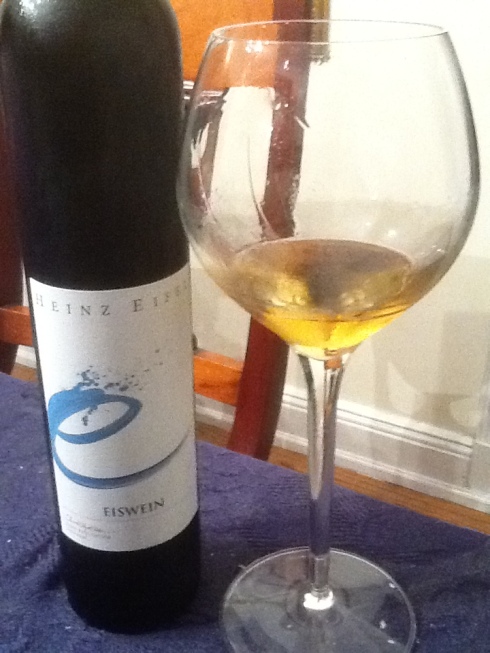Couronne & Lions Sancerre, Loire Valley, 2012
$18 from Mayfair Wine & Liquor
Pale straw in color with a hint of green on the tinge. A nose of white peach, hibiscus, and citrus with a note of chalky clay. In the mouth, gooseberry, grapefruit, lemon, and lychee flavors dominate the palate and are followed by sharp acidity, with notes both sweet and sour on the upper palate and during the finish. A nicely made sancerre that will also please lovers of sauvignon blanc; I think this wine shines best when served quite cold.
Heinz Eifel Eiswein
375ml bottle, $18 from Mayfair Wine & Liquor
The color is a lovely orange sunset and the nose reminds me of candied apples with pears poached in brandy. The palate of this sweet wine is ripe pear, apricot & plum, dominated by the sugary sweetness of the blend and a hint of must. I’m stunned to find an eiswein so similar to a sauternes. After three separate tastings on different days, my notes all agree: at the right temperature (serve very cold), this eiswein is a superb dessert wine.





German wines are just fabulous. Love them. You can definitely use musty on aged whites, too, because they can have that particular nose…
Old shoe? My worst was old socks…as in socks worn for three days while running in very old running shoes…:)
I am way too unfamiliar with Sauternes. Who knows? Their nose might smell like Riesling Auslesen to me…
LikeLike
I have used musty and moldy in red wine descriptions. Quick aside: I once had a VERY expensive wine that was on the edge: beneath the aged fruit and super smooth tannins it had a nose with a ton of barnyard, some moldiness and I swear to you, the essence of old shoe. I’d like to not experience the aroma of “old shoe again” ever (aged saddle leather and sweat would certainly come close if I needed a different description) but the sauternes similarity in the Heinz eiswein is simply stunning. Oliver, I thank you so much for your excellent point and insight to the amazing region of Rhinehessen- I have much to learn about German wine, and am loving it!
LikeLike
Hmmmm, technically a German Eiswein is not allowed to have botrytis. The grapes must be 100% healthy, and even a hint of botrytis leads to it not being allowed to be labeled as an Eiswein (a couple of court decisions upheld that provision in the last few weeks)….but maybe Eifel just managed to get waved through…
LikeLike
No, you’re absolutely correct. I’m using the term botrytis to represent the flavor or essence of “over-ripe to slightly moldy”, and I expect I’ve used it incorrectly. Any suggestions to help me clarify?
LikeLike
Yeah, I get what you mean….I always struggle describing that aroma. I just thought the word botrytis is confusing in ice wine because the rot is just not allowed….
Maybe “musty” could be a word? I struggle with describing what I think I know what you get all the time…even in German.
LikeLike